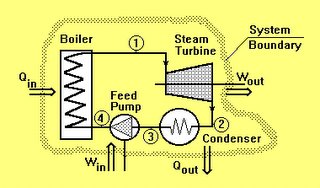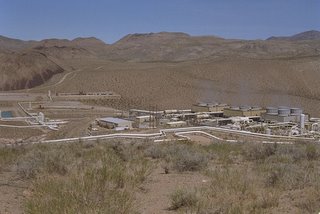The previous Career Autobiography post is here.
The above photo is one of the facilities that I worked at. It is the three-unit Navy 1 geothermal plant at China Lake, CA. Geothermal energy is fascinating below ground, and fairly mundane above ground :)
Our current understanding of the earth is that there are large tectonic plates, 10-100 miles thick, floating on a liquid magma core of molten rock. Why is the center of the earth so hot? There are three reasons:
1. Residual heat from compression of the earth's mass coalescing to form this planet.
2. Radioactive decay of naturally occuring unstable elements - primarily Uranium and Thorium.
3. Fluid friction as the magma is churned by the rotation of the earth.
Interestingly the earth would be cooled and solid throughout if it were not for #2. But weak and diffuse as the heat generated by the odd radioactive decay is, 100 miles of rock is enough to insulate that heat from being lost.
So how do we take advantage of the tremendous potential of all this heat? Well, it's not so easy, engineering-wise. Even 10 miles of solid rock is a lot to drill down through. Try digging a 6 inch deep hole into a large boulder. Tough, isn't it?
Fortunately there are a few places on the earth where the heat comes to us :) These places are typically where tectonic plates meet. Additionally there are a few places where a plume of magma rises to the surface of the earth without being near a plate boundary. Hawai'i and Yellowstone are two of these. For the most part however magma is closest to the surface near a plate boundary.
Looking at the map in the above link, it looks like there should be plenty of places on the earth where geothermal energy would work well, although it looks like Kansas is probably out of the running :) So how do we take advantage of magma that makes its way near the surface? Well, there's a second caveat: We need to have a hydrothermal resource - a heated underground aquifer.
Water (or steam) is the most effective medium we know of to bring that heat to the surface, and the Rankine Cycle is the best process known to turn steam energy into electricity. Without water, geothermal energy becomes a technical challenge worthy of NASA in the Apollo days.
Below is a picture of how the Rankine, or steam cycle works. In geothermal power, the earth takes the place of the piece labeled "Boiler" ("Qin" is engineering speak for "heat input"). The steam leaves the boiler at the top, travels through a steam line to the turbine at the right, spins it and an attached electrical generator ("Wout"), then the spent steam exits into a condenser, where it is condensed back into water. A feed pump removes the condensed water and pumps it back into the boiler to start the cycle all over again using the same water. In geothermal systems the water is pumped back into the ground.

So now we've seen how the process works, and understand why we need both heat and an aquifer. Let me add two *more* requirements that might not be obvious at first glance: We need the heated aquifer to reside in permeable earth, so that the water or steam can migrate underground to our well, and we also need a large enough aquifer to supply the steam for the power plant we're going to build. Takes a lot of "just right" conditions to make electricity (or building heating) from geothermal. Kind of a bummer, huh?
So how do we develop a geothermal power plant?
We drill a few test wells (for several million dollars each, depending on the depth of the resource). Some wells can be 10,000 feet deep, while others can be as little as 250 ft. Actually it's a little scary knowing that such hot water is at such a shallow depth! Anyway, the wells are flowed for a month or so, while the flow, temperature, pressure, and chemistry are logged. If the resource proves adequate in terms of mass flow and heat content, the developer will try to obtain financing from a very large bank - one that doesn't mind taking some risk on a natural-resource dependent asset.
So how does it all work once the finance is done and the plant is built? There are (more or less) two types of geothermal plants, although both use the same rankine cycle. I'll describe the simpler one first:
The flash type. Water and steam under high pressure and temperature are expelled from the pressurized and permeable rock zone known as a "reservoir" into wells. Several wells bring a superheated water/steam mixture to the surface. The flow from these wells is directed into 'separators' These are the tall structures in the wellfield and power plant in the photo. The purpose of the separator is to separate the steam and water from one another. The steam exits the top, and the water falls to the bottom. The water is re-injected into the wellfield for replenishment. The steam is sent to a turbine. The turbine turns a generator, and voila! Electricity!
The other type of geothermal plant is called a 'binary' unit.
In this case the underground aquifer is either not hot enough to become steam (less than 212 degrees F), or it has so much mineral content that flashing it would precipitate silica and calcium and render the piping systems useless. Here is a work-around for either of those issues.
Assume the geothermal fluid is too cool to flash to steam: The liquid is pumped to the surface, and passed through a heat exchanger. The geothermal water passes through a bundle of tubes which are submerged in a second liquid. This second liquid has a lower boiling point than water, but otherwise behaves similarly in a steam system. In this case the "boiler" in the diagram is actually a boiler. The downsides to binary are two-fold. The secondary liquid is usually flammable butane or pentane, and efficiency isn't as good as with flash types. But considering that there are no fuel costs, efficiency is less of an issue than it would be for a fossil-fired unit.
Of interest is the fluid that is re-injected into the ground. It is quite a bit cooler than the surrounding underground aquifer. It's important to recover as much as possible of the injected fluid, or we run the risk of depleting the reservoir. However, it's just as important that the cold fluid not migrate to production wells too quickly, or it will quench them and cause them to stop flowing. Significant effort goes into modeling the underground flows of steam and water. Volatile and non-volatile chemicals are injected to determine migration times between injection and production wells. It was a learning process. Eventually injection wells were scattered throughout the producing wellfield, at various depths, and flowrates were adjusted as migration paths and times were better understood. Fascinating stuff.
There is a more detailed description of operational issues associated with geothermal energy here.



No comments:
Post a Comment